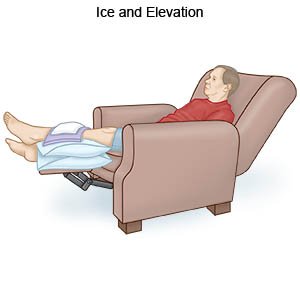Calcaneal Fracture
Medically reviewed by Drugs.com. Last updated on Apr 6, 2025.
A calcaneal fracture is a break in your calcaneus (heel bone).
DISCHARGE INSTRUCTIONS:
Call your local emergency number (911 in the US) if:
- You suddenly feel lightheaded and short of breath.
- You have chest pain when you take a deep breath or cough.
- You cough up blood.
Return to the emergency department if:
- You have severe pain.
- Your cast breaks or gets damaged.
- Your toes are numb, swollen, cold, or pale.
- Your leg feels warm, tender, and painful. It may look swollen and red.
Call your doctor if:
- You have a fever.
- You have new blood stains or a bad smell coming from under your cast.
- You have increased pain or swelling, even after treatment.
- You have questions or concerns about your condition or care.
Medicines:
You may need any of the following:
- Prescription pain medicine may be given. Ask your healthcare provider how to take this medicine safely. Some prescription pain medicines contain acetaminophen. Do not take other medicines that contain acetaminophen without talking to your healthcare provider. Too much acetaminophen may cause liver damage. Prescription pain medicine may cause constipation. Ask your healthcare provider how to prevent or treat constipation.
- Antibiotics help fight or prevent a bacterial infection.
- Take your medicine as directed. Contact your healthcare provider if you think your medicine is not helping or if you have side effects. Tell your provider if you are allergic to any medicine. Keep a list of the medicines, vitamins, and herbs you take. Include the amounts, and when and why you take them. Bring the list or the pill bottles to follow-up visits. Carry your medicine list with you in case of an emergency.
Self-care:
- Rest your heel as much as possible. Return to normal activities as directed.
- Apply ice to your heel to decrease swelling and pain. Use an ice pack, or put crushed ice in a plastic bag. Cover the bag with a towel before you place it on your heel. Apply ice for 15 to 20 minutes every hour or as directed.
- Elevate your heel above the level of your heart as often as you can. This will help decrease swelling and pain. Prop your leg on pillows or blankets to keep your heel elevated comfortably.

- You may need to take showers until your healthcare provider says a bath is okay. If you have a cast, cover it with 2 plastic trash bags before you bathe. Tape the bags to your skin to keep the water out. Try to bathe with your foot out of the water in case the bag breaks.
- Go to physical therapy if directed. A physical therapist teaches you exercises to help improve movement and strength, and to decrease pain.
Follow up with your doctor as directed:
Write down your questions so you remember to ask them during your visits.
© Copyright Merative 2025 Information is for End User's use only and may not be sold, redistributed or otherwise used for commercial purposes.
The above information is an educational aid only. It is not intended as medical advice for individual conditions or treatments. Talk to your doctor, nurse or pharmacist before following any medical regimen to see if it is safe and effective for you.
Further information
Always consult your healthcare provider to ensure the information displayed on this page applies to your personal circumstances.
